
Serving Wine
It can seem at times there there are any number of rules about serving wine that you have to keep straight. The real truth is that while some conventions may enhance the enjoyment of wine, there is nothing more required than a way to open the bottle and something to pour it into. That said, here are some of the finer points of wine, that you may do with as you wish.
Food And Wine Pairing (easy answer: Drink what you like, with whatever you like)
1) "White wine with white flesh, Red with red"- is at the very least, antiquated.
2) If a very simple rule of thumb needs to exist it would be better off saying "White with Light and Red with Rich". Preparation and sauce are more important than what is being cooked with Game being a notable exception.
3) Oil and vinegar. The acid of the vinegar cuts the unctuousness of the oil and vice versa. Apply this to wine and you end up with acidic wines like Pinot Noir with oily foods like salmon. This principal is very important and is one of the least touted by others.
4) Food and wine, like wine itself is a balance (much like life). Although in this case opposites do balance such as a lightly sweet white (i.e. Auslese, LH Chenin Blanc, etc...) with very spicy food of any type, never underestimate pairing similar flavors. Pinot Noir stands up quite well to lemon, no doubt the high acids in each are complementary.
5) Match flavors. This is so simple that it is often overlooked. The grapefruit/citrus taste of Sauvignon Blancs goes with fish as well as and for the same reason that lemon does.
6) Avoid wines that are predominated by non-food flavors. Oak is not a taste you expect to find in food. Save oaky wines for fireside chats and other non food events.
7) Don't be afraid of a little sugar. Most Americans love sweetened ice tea and other 'soft drinks'. A slightly sweet wine, be it California Gewurztraminer, a German Spatlese, or an Anjou from the French Loire, is sure to be a crowd pleaser when served with the right food (say acidic or hot food).
8) Never pair a wine with any food that is sweeter than it. This makes the term Dessert Wine to be a misnomer. Most sweet wines are best enjoyed after dessert.
Some swear by Chocolate and Cabernet Sauvignon, which violates this rule. Try it for yourself sometime (and then try a Black Muscat like Quady's Elysium).
9) Above all other considerations, drink wine to enjoy it and the company you are sharing it with. Food and wine pairings are elusive and to some degree mythical. Drink wine you like with food you like, but never stop experimenting.
The Best Temperature to Serve Wine
The temperature to drink wine at is one of those personal preferences that too often is espoused as fact.
I personally tend to drink all of my dry wine directly out of the cellar. Red wines warm up quickly in the glass, and the evolution of flavors is fun to observe. For white wines I use a chilled marble cooler to keep the wine cool, but not cold.
For Champagne or sparkling wine I refrigerate the wine for several hours and then keep it around 40 degrees by keeping it in ice (but no water in the bucket).
Sweet wines I like very cold, so I chill them in salted ice water (it only takes them about 5 minutes to cool if they were previously in the cellar). I keep the sweet wine in the freezing brine mixture to keep it as cold as possible.
What is more certain is to not let any wine become too warm. A red wine as cool 80F degrees will taste noticeably alcoholic. White wine is more delicate and therefore has less to disguise the alcohol and other less pleasant aspects of the wine, and so is more easily enjoyed when it is actually cooler that 60F. Sweet wines paradoxically, can actually be served quite warm (as Ports and other fortified wines are). I prefer my sweet white wine to be very cold, but they do not have as much alcohol to interfere with the flavor, and the residual sugar masks pretty much everything else.
Experiment to find your own preferences, but don't stress on finding the exact correct temperature. No matter what you decide on there will always be an expert (other than myself) that will disagree with you.
How to Open Sparkling Wine
For all videos, click on name in the upper left of the video to see it larger on Youtube.
How Not to Open Sparkling Wine (with a knife!)
Wine Accessories
In a misguided moment that lasted 5 years, I owned and operated a mail order wine accessory business. I escaped with my life and little else, except years of experience in evaluating every wine accessory made.
Here are the highlights, every thing you really need to know about wine toys.
(I prefer not to endorse any retailer over another, just know that you can buy any of these from a wine accessory catalog)..
Corkscrews
You have to have a corkscrew to drink wine with a cork.
Screwpull
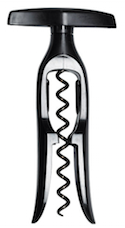
Screwpulls are the ones I recommend. They run about $30. They are simple and effortless. Some Styles have no knife so make sure you get a foil cutter with it (although I usually just pull the foil off, it makes for easy recycling).
Ah-So
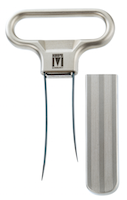
The Ah-So, a two bladed cork pull (it doesn't have a screw) is also great, especially with older wines. The Ah-So is not easy to use, but once you are good at it, nothing else will do.
Here is a video of how to use it:
Waiter's Friend
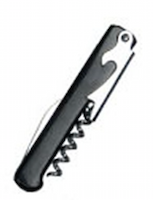
The classic waiter's friend is better than most other alternatives. Look for one with a sharp knife; grooved, long screw and a "floating boot". The lever part is the boot, and if it can slide in a notch, it is the right kind.
Lever Pull
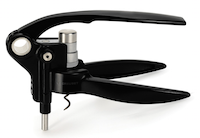
The Leverpull from the Screwpull people is awfully nice. If the high price tag doesn't scare you away, it is the one to have.
Jumping Jack
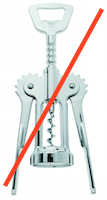
My pet peeve in corkscrews are actually one of the most common types. I call them Jumping Jacks. They have two arms that raise as you turn the screw.
This type of corkscrew is probably responsible for more mutilated corks than other other types put together. I would honestly prefer to use a Swiss Army Knife.
The screw on these are too short and too wide, and the handles pull the cork too hard.
Wine Glasses
The Facts
After a way to open a bottle, having something to drink out of is the most important accessory.
Fortunately most wine glasses are good enough.
Make sure the glasses are not frosted, colored or cut, so you can see the wine clearly.
Look for glasses that are more narrow at the mouth then the bowl. Brandy snifters are a surprisingly good wine glass.
Make sure they are not too big (6 oz. is fine, you will only be pouring about 3 oz. at a time).
If you need glasses for wine tasting rather than drinking, make sure that you have many identical glasses. For this the INAO is the world standard, and can be found for around $5 a stem.
The Debate
Big name wine glasses that purport to offer specific shapes for specific wine styles are dubious. They, like most fine crystal feel great in your hands and that alone adds something to the experience of drinking wine, but my tests have not borne out their lavish claims. Different glasses do make wine taste differently, but the concept of the single perfect stem for a single style is somewhat absurd, not only because there are just too many styles within any class of wine, but because if you buy into the hype you would have to have hundreds and hundreds of glasses, each costing the price of a decent bottle of wine!
Decanters
The Facts
One of the most important accessories for drinking older wine that have accumulated sediment, although I often just use a clean, empty wine bottle.
If you rarely drink wines with sediment this is not an accessory for you.
Look for a wide bottom and a narrow neck.
You will need a decanting funnel ideally, so the wine will gently pour down the side of the decanter.
Traditionally one uses a candle under the neck of the bottle to illuminate the wine to keep from pouring sediment. In this modern age I use a tiny flashlight, not as hot as a candle.
Expect to pay $100 and up, way up for a fine decanter.
The Debate
As to the need to decant younger wines, or any wine, so it can "breath." I have conducted many tests on the subject and have never found this common assertion to be true. There is any amount of contradictory advice on what type of wine requires being decanted, and how long to leave it, but my tests have shown that even if left wide open for an hour, wine doesn’t change fast enough for even experienced tasters to notice a difference. It is fun and it looks good to decant a wine, but it is not necessary unless it is old - in order to remove sediment - or it has an off aroma - which forceable decanting (glug glug) might improve.
Preserving an Open Bottle of Wine
What to do with wine if you can't finish the bottle is a problem most of us have faced.
The theory is that you want to be able to keep the harmful oxygen away from the remaining wine.
Vacuum Pumps
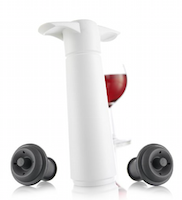
The Vacuum pumps are better than nothing, but just barely.
The concept sounds good, remove the air by pumping it out, therefore removing the risk of dangerous oxygen allowing anything nasty to live in the wine.
The only problem is that you can only pump out so much of the air with these things. Even if you could remove all of the air you would quickly learn what happens to liquids in a vacuum.
Spray Cans

A mixture of inert gasses that can do a decent job of keeping oxygen away from your wine with a few caveats. You have to really carefully follow directs, and then you have to really never move the bottle. Less expensive up front cost, but in the long run a Nitrogen Bar System may end up working better and being cheaper.
Bar Systems
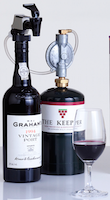
Usually found in bars and restaurants, there are also smaller systems with disposable Nitrogen tanks for home use. A well proven system that I have used myself with great success. Not only does it preserve the wine (tap it before pouring any wine, for best results) it makes it easy to pour, and to have a selection of wines on hand. Preserves wines for a week or more.
Coravin
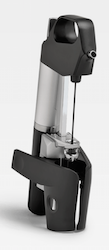
The latest thing. Instead of ever removing the cork, you pierce it with a fine needle, drawing out just the amount of wine you want, and leaving the wine corked, with inert gas replacing the missing wine. I have never used one of these, but they sound like a good idea. Quite pricey.
Plug in Wine Cellars
These refrigerator like appliances allow you to create a cellar like environment anywhere. I have had 2 in my living room for years, and for the wine collector who lives without a cellar, these are a must. Expect to pay well over $1000.
Personally I like and have used the Eurocave brand for years. They work by sending the coolant through the sides of the cellar, instead of blowing cold air. On the down side these are the most expensive units you can have.
If you need to store wine for less than 20 years and would rather buy wine than wine toys, store your wine in a camping cooler (or several). These well insulated containers will keep the wine from changing temperature too quickly and will let it age more than adequately.There is something about walking into a wine cellar, choosing a bottle of wine, uncorking it and serving it, all in the same room. Nothing can take more money out of your wine budget than a cellar.
You need to make sure that your wine ages slowly and for as long as possible, you need temperature control.
Wine Cellar Cooling units are like any air conditioner, other than they are designed to maintain a steady and cooler temperature. The better ones are also careful about drying out the air too much. If you want your cellar to be perfect, make sure you have one of these.
For those without a true cellar, you can get prefab cellars that are free standing that use these same cooling units.Vibration and light are the hidden enemies of wine. Beware of units that have noisy fans, or clear glass doors.
Multi temperature units are also dubious. They work by the principal that heat rises, so they cool the bottom part of the cellar the most, and the top the least. This means that the temperature through out your cellar is different.
You are better off chilling your wines in a good old fashioned refrigerator, while keeping the rest of your wines at a steady 55F throughout your entire cellar.
Remember that in a pinch a salted bucket of ice water will chill a bottle of wine in about 5 minutes.
